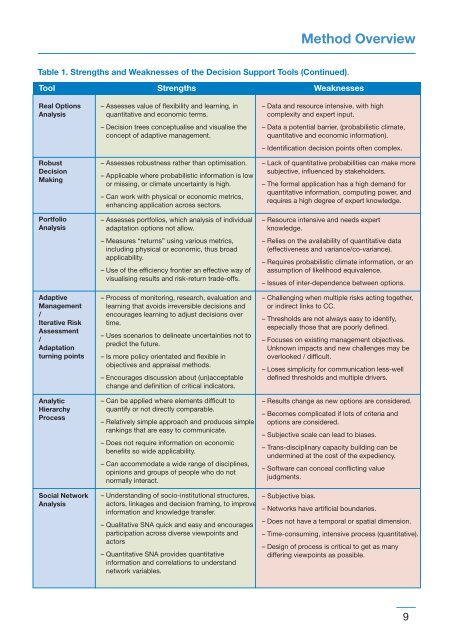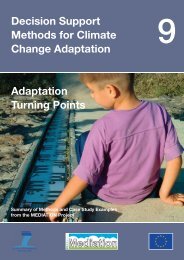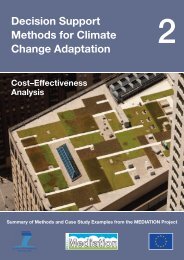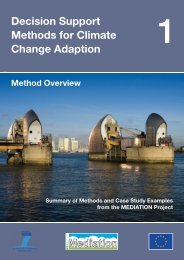Download all Technical Policy Briefing Notes in a single ... - Mediation
Download all Technical Policy Briefing Notes in a single ... - Mediation
Download all Technical Policy Briefing Notes in a single ... - Mediation
- No tags were found...
You also want an ePaper? Increase the reach of your titles
YUMPU automatically turns print PDFs into web optimized ePapers that Google loves.
Method OverviewTable 1. Strengths and Weaknesses of the Decision Support Tools (Cont<strong>in</strong>ued).Tool Strengths WeaknessesReal OptionsAnalysisRobustDecisionMak<strong>in</strong>gPortfolioAnalysisAdaptiveManagement/Iterative RiskAssessment/Adaptationturn<strong>in</strong>g po<strong>in</strong>tsAnalyticHierarchyProcessSocial NetworkAnalysis– Assesses value of flexibility and learn<strong>in</strong>g, <strong>in</strong>quantitative and economic terms.– Decision trees conceptualise and visualise theconcept of adaptive management.– Assesses robustness rather than optimisation.– Applicable where probabilistic <strong>in</strong>formation is lowor miss<strong>in</strong>g, or climate uncerta<strong>in</strong>ty is high.– Can work with physical or economic metrics,enhanc<strong>in</strong>g application across sectors.– Assesses portfolios, which analysis of <strong>in</strong>dividualadaptation options not <strong>all</strong>ow.– Measures “returns” us<strong>in</strong>g various metrics,<strong>in</strong>clud<strong>in</strong>g physical or economic, thus broadapplicability.– Use of the efficiency frontier an effective way ofvisualis<strong>in</strong>g results and risk-return trade-offs.– Process of monitor<strong>in</strong>g, research, evaluation andlearn<strong>in</strong>g that avoids irreversible decisions andencourages learn<strong>in</strong>g to adjust decisions overtime.– Uses scenarios to del<strong>in</strong>eate uncerta<strong>in</strong>ties not topredict the future.– Is more policy orientated and flexible <strong>in</strong>objectives and appraisal methods.– Encourages discussion about (un)acceptablechange and def<strong>in</strong>ition of critical <strong>in</strong>dicators.– Can be applied where elements difficult toquantify or not directly comparable.– Relatively simple approach and produces simplerank<strong>in</strong>gs that are easy to communicate.– Does not require <strong>in</strong>formation on economicbenefits so wide applicability.– Can accommodate a wide range of discipl<strong>in</strong>es,op<strong>in</strong>ions and groups of people who do notnorm<strong>all</strong>y <strong>in</strong>teract.– Understand<strong>in</strong>g of socio-<strong>in</strong>stitutional structures,actors, l<strong>in</strong>kages and decision fram<strong>in</strong>g, to improve<strong>in</strong>formation and knowledge transfer.– Qualitative SNA quick and easy and encouragesparticipation across diverse viewpo<strong>in</strong>ts andactors– Quantitative SNA provides quantitative<strong>in</strong>formation and correlations to understandnetwork variables.– Data and resource <strong>in</strong>tensive, with highcomplexity and expert <strong>in</strong>put.– Data a potential barrier, (probabilistic climate,quantitative and economic <strong>in</strong>formation).– Identification decision po<strong>in</strong>ts often complex.– Lack of quantitative probabilities can make moresubjective, <strong>in</strong>fluenced by stakeholders.– The formal application has a high demand forquantitative <strong>in</strong>formation, comput<strong>in</strong>g power, andrequires a high degree of expert knowledge.– Resource <strong>in</strong>tensive and needs expertknowledge.– Relies on the availability of quantitative data(effectiveness and variance/co-variance).– Requires probabilistic climate <strong>in</strong>formation, or anassumption of likelihood equivalence.– Issues of <strong>in</strong>ter-dependence between options.– Ch<strong>all</strong>eng<strong>in</strong>g when multiple risks act<strong>in</strong>g together,or <strong>in</strong>direct l<strong>in</strong>ks to CC.– Thresholds are not always easy to identify,especi<strong>all</strong>y those that are poorly def<strong>in</strong>ed.– Focuses on exist<strong>in</strong>g management objectives.Unknown impacts and new ch<strong>all</strong>enges may beoverlooked / difficult.– Loses simplicity for communication less-welldef<strong>in</strong>ed thresholds and multiple drivers.– Results change as new options are considered.– Becomes complicated if lots of criteria andoptions are considered.– Subjective scale can lead to biases.– Trans-discipl<strong>in</strong>ary capacity build<strong>in</strong>g can beunderm<strong>in</strong>ed at the cost of the expediency.– Software can conceal conflict<strong>in</strong>g valuejudgments.– Subjective bias.– Networks have artificial boundaries.– Does not have a temporal or spatial dimension.– Time-consum<strong>in</strong>g, <strong>in</strong>tensive process (quantitative).– Design of process is critical to get as manydiffer<strong>in</strong>g viewpo<strong>in</strong>ts as possible.9





